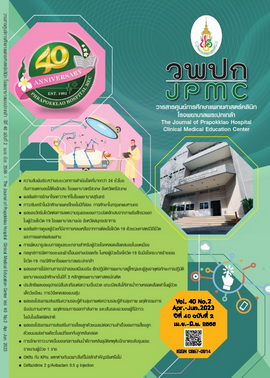Association between Duration of Onset Longer than 24 Hours and Perforated Appendicitis in Si Sa Ket Hospital: A Hospital-based Case-control Study
Main Article Content
Abstract
BACKGROUND: The incidence of ruptured appendicitis is very common among the general public, particularly in children and the elderly, which affects the duration of treatment and patient mortality.
OBJECTIVES: To study the relationship between the duration of disease progression greater than 24 hours and the occurrence of ruptured appendicitis.
METHODS: A Hospital-based case-control study was conducted to obtain data from medical records. The study group included 167 individuals with ruptured appendicitis, whereas the control group included 167 patients with pathologically confirmed non-ruptured appendicitis. All patients were admitted to Si Sa Ket’s Hospital. After collecting data between January 1 and December 31, 2019, multivariable logistic regression was applied to explore the association.
RESULTS: After correcting for the impact of gender, age, and the Alvarado score, the results of multivariable regression analysis revealed that a delay of more than 24 hours between the onset of abdominal discomfort and the visit to the operating room increased the incidence of ruptured appendicitis, which was statistically significant. It was discovered that patients who experienced stomach pain for longer than 24 hours before having surgery had a 2.76 times higher risk of developing an appendicitis rupture compared with the group whose time to surgery was no longer than 24 hours (ORadj=2.76, 95%CI=1.68–4.52). Moreover, this study found that, the likelihood of appendicitis rupture rose to 4.15 times if the period from the beginning of abdominal discomfort to the patient's arrival at the operating room was more than 36 hours (ORadj=4.15, 95%CI=2.57–6.66).
CONCLUSIONS: The time between the onset of symptom and surgical intervention appeared to be strongly correlated with cases of rupture appendicitis. As a result, public awareness concerning the usage of both emergency medical services and physicians is critical to the management of appendicitis in order to lower the incidence of ruptured appendicitis.
Article Details

This work is licensed under a Creative Commons Attribution-NonCommercial-NoDerivatives 4.0 International License.
References
Sirikurnpiboon S, Amornpornchareon S. Factors associated with perforated appendicitis in elderly patients in a tertiary care hospital. Surg Res Pract [Internet]. 2015 [cited 2021 Sep 18]; 2015:847681. Available from: https://www.ncbi.nlm.nih.gov/pmc/articles/PMC4561309/pdf/SRP2015-847681.pdf
Schwartz SI. Principles of surgery: pretest self-assessment and review. 7nd ed. New York: McGraw-Hill Publishing; 1999.
Greenfield LJ, Mulholland M, Oldham KT, Zelenock GB, Lillemoe KD. Surgery: scientific principles and practice. 2nd ed. Philadelphia: Lippincott Williams & Wilkins; 1999.
Addiss DG, Shaffer N, Fowler BS, Tauxe RV. The epidemiology of appendicitis and appendectomy in the United States. Am J Epidemiol 1990;132:910-25.
Temple CL, Huchcroft SA, Temple WJ. The natural history of appendicitis in adults. A prospective study. Ann Surg 1995; 221:278-81.
Atiksawedparit P, Sittichanbuncha Y. Associated factors of ruptured appendicitis in acute appendicitis patients at the emergency department, Ramathibodi hospital. Thammasat Medical Journal 2013;13:36-42.
Sheu BF, Chiu TF, Chen JC, Tung MS, Chang MW, Young YR. Risk factors associated with perforated appendicitis in elderly patients presenting with signs and symptoms of acute appendicitis. ANZ J Surg 2007;77:662-6.
Thitisurawat A, Eaupanitcharoen S. Factors associated with perforated appendicitis in elderly patients at Debaratana Nakhon Ratchasima hospital. Maharat Nakhon Ratchasima Hospital Medical Bulletin 2018;40:171-6.
Nuntasunti W. Effect of time to the risk of perforation in pediatric appendicitis. Medical Journal of Srisaket Surin Buriram Hospitals 2016;31:149-62.
Vissers RJ, Lennarz WB. Pitfalls in appendicitis. Emerg Med Clin North Am 2010;28:103-18.
DeKoning EP. Acute Appendicitis. In: Tintinalli J, Stapczynski J, Ma OJ, Cline D, Cydulka R, Meckler G. Tintinalli's emergency medicine: a comprehensive study guide. 7th ed. New York :McGraw Hill; 2011. p. 574-8.
Kim M, Kim SJ, Cho HJ. Effect of surgical timing and outcomes for appendicitis severity. Ann Surg Treat Res 2016;91:85-9.
Andersson REB. Meta-analysis of the clinical and laboratory diagnosis of appendicitis. Br J Surg 2004;91:28-37.
Augustin T, Cagir B, Vandermeer TJ. Characteristics of perforated appendicitis: effect of delay is confounded by age and gender. J Gastrointest Surg 2011;15:1223-31.
Tantarattanapong S, Arwae N. Risk factors associated with perforated acute appendicitis in geriatric emergency patients. Open Access Emerg Med [Internet]. 2018 [cited 2021 Sep 18];10:129-34. Available from: https://www.ncbi.nlm.nih.gov/pmc/articles/PMC6174914/pdf/oaem-10-129.pdf
Sheu BF, Chiu TF, Chen JC, Tung MS, Chang MW, Young YR. Risk factors associated with perforated appendicitis in elderly patients presenting with signs and symptoms of acute appendicitis. ANZ J Surg 2007;77:662-6.
Omari AH, Khammash MR, Qasaimeh GR, Shammari AK, Yaseen MK, Hammori SK. Acute appendicitis in the elderly: risk factors for perforation. World J Emerg Surg [Internet].2014 [cited 2021 Sep 18];9:6. Available from: https://www.ncbi.nlm.nih.gov/pmc/articles/PMC3896723/pdf/1749-7922-9-6.pdf
Paziogas B, Tsiaousis P, Koutelidakis I, Giakoustidis A, Atmatzidis S, Atmatzidis K. Effect of time on risk of perforation in acute appendicitis. Acta Chir Belg 2009;109: 75-80.

